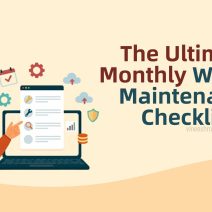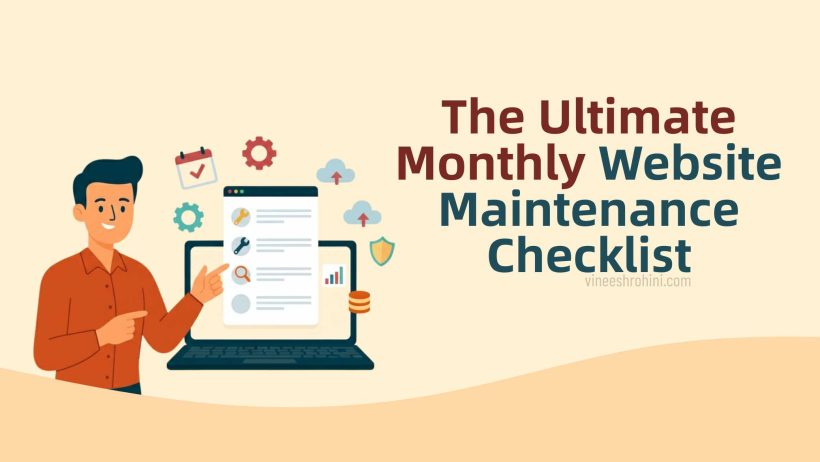Website Maintenance : In the digital-first era, a website has become the beating heart of every modern business. Whether you operate a multinational company, a small local shop, or a personal blog, your website acts as the first impression for potential customers and the main communication channel with your audience.
Table of Contents
A well-designed, functional, and updated website can increase brand credibility, generate leads, and even convert casual visitors into loyal customers. But having a great-looking website is not enough. Websites, much like any other digital or physical asset, require ongoing care and attention. Without regular maintenance, websites can become outdated, insecure, and slow, ultimately damaging your reputation and profitability. This is why having a monthly website maintenance checklist is crucial for long-term success.
Website maintenance is often overlooked by many businesses, especially startups and entrepreneurs who are more focused on design and content creation. However, neglecting website upkeep can result in broken links, outdated content, technical glitches, poor SEO rankings, and even data breaches. These issues not only frustrate users but also harm your position in search engine results, leading to reduced traffic and lost revenue opportunities. By adopting a structured monthly maintenance strategy, you safeguard your website against potential risks while ensuring that your digital presence remains optimized, secure, and user-friendly.
This comprehensive blog will walk you through the ultimate monthly website maintenance checklist, covering every aspect from technical updates to SEO monitoring. Each section will explore why a particular task matters, how to perform it effectively, and what benefits it delivers to your business. By the end, you’ll understand that maintaining your website is not just a technical necessity but a strategic investment in the growth and sustainability of your online presence.
Why Monthly Website Maintenance Is Essential

The online world evolves rapidly, with new technologies, security threats, and user expectations emerging almost every day. A website that was functioning perfectly three months ago may now face performance or security challenges. Regular monthly maintenance allows you to keep pace with these changes while ensuring that your site remains competitive.
The benefits of consistent maintenance include:
- Improved Website Security: Hackers constantly look for vulnerabilities in outdated plugins, themes, or CMS systems. Regular updates and scans protect your site and your users.
- Enhanced User Experience: Visitors expect websites to load quickly, look professional, and function seamlessly across devices. Regular checks help maintain this standard.
- Stronger SEO Rankings: Search engines favor websites that are updated, error-free, and fast. Neglecting maintenance can gradually drop your rankings.
- Higher Conversion Rates: A smooth website free from glitches encourages users to stay longer and convert into paying customers or subscribers.
- Reduced Downtime Risks: Regular monitoring ensures that small issues are fixed before they become big problems, saving you from unexpected downtime.
Also Read : Best Website Builders For Online Stores : Comprehensive Guide 2025
By implementing a thorough monthly checklist, you can address both technical and content-related tasks systematically, ensuring that your website remains in peak condition.
Updating Software, Plugins, and Themes
The first step in any monthly maintenance checklist should be updating your website’s software, plugins, and themes. Whether you are using WordPress, Joomla, Shopify, or another CMS platform, regular updates are essential. Developers release updates not only to introduce new features but also to patch security vulnerabilities. Ignoring updates can leave your site exposed to hackers who exploit outdated code.
For example, a plugin that was installed a year ago may now have multiple patches available due to security loopholes discovered by cybercriminals. If these updates are not applied, your website becomes a target. Performing updates monthly ensures that your site is equipped with the latest protective measures and is functioning optimally. Before applying updates, always test them on a staging site if possible to avoid compatibility issues.
Backing Up Your Website

A website backup is like an insurance policy. No matter how careful you are, accidents happen—servers crash, websites get hacked, or files get corrupted. Without a backup, restoring your website can be impossible or extremely expensive.
As part of your monthly routine, perform a complete backup of your website files, databases, and configurations. Store these backups in at least two secure locations, such as cloud storage and an external hard drive. Some businesses prefer automated backup tools that run weekly or even daily, but a thorough manual backup once a month ensures you have a reliable version available in case of emergencies. Importantly, test your backup occasionally by performing a restore process to confirm that it actually works.
Performing Security Checks
Website security is one of the most critical aspects of online success. A single data breach can compromise customer information, damage your reputation, and even result in legal consequences. Monthly security checks help you stay ahead of potential threats.
Run a comprehensive malware scan and vulnerability test every month using trusted security tools. Review your access logs to identify suspicious login attempts. Make sure only authorized individuals have admin access and remove outdated accounts. Check the status of your SSL certificate and renew it if needed. Adding firewalls and using strong password policies are also part of a proactive security routine.
Website Speed and Performance Testing
Users today expect websites to load within seconds. A delay of even one or two seconds can cause visitors to leave and never return. Additionally, search engines like G use page speed as a ranking factor. This makes monthly speed tests essential.
Tools like GTmetrix or G PageSpeed Insights can help you evaluate your site’s load times and identify problem areas. Common culprits include unoptimized images, heavy scripts, and too many HTTP requests. By compressing images, enabling caching, and reducing unnecessary code, you can significantly improve site speed. Monitoring performance monthly allows you to maintain consistent user satisfaction and SEO performance.
Reviewing and Updating Content
Content is not static; it needs to be updated regularly to remain relevant and valuable. Outdated information, broken statistics, or expired promotions can frustrate users and damage trust. As part of your monthly maintenance checklist, review your website content thoroughly.
Update blog posts with new insights, revise service pages with accurate details, and ensure product descriptions remain current. Adding fresh content also signals to search engines that your website is active, improving your visibility. For businesses, this step is not only about maintenance but also about seizing opportunities to connect with audiences through timely updates.
Checking for Broken Links
Few things are more frustrating for a user than clicking a link only to find a “404 Page Not Found” error. Broken links disrupt user experience and harm your search engine rankings. Each month, run a broken link checker across your website to identify faulty internal and external links. Replace them with working URLs or remove them altogether. Fixing broken links improves navigation, retains user trust, and ensures your website remains SEO-friendly.
Testing Forms and Interactive Elements
Forms are the gateway to user interaction, whether for newsletter subscriptions, lead generation, or purchases. A malfunctioning form can mean lost business opportunities. Each month, test every form on your site to ensure it works properly. Verify that submissions are being delivered to the correct inbox or database. Double-check that CAPTCHA systems function and that thank-you or confirmation messages display correctly. Testing forms regularly ensures you never lose valuable leads due to technical errors.
Mobile Optimization Checks
The majority of global website traffic now comes from mobile devices. If your site is not mobile-friendly, you risk alienating more than half of your potential audience. Monthly mobile optimization checks help you identify layout issues, oversized images, or buttons that don’t work well on smaller screens. Ensure that your design is responsive and that every page looks seamless across devices. Prioritizing mobile usability improves user satisfaction and boosts your SEO rankings since G follows a mobile-first indexing approach.
SEO Performance Review

Search engine optimization is not a one-time task; it’s an ongoing process that requires constant attention. Every month, review your website’s SEO performance using analytics tools. Track keyword rankings, organic traffic, and backlink growth. Identify underperforming pages and improve them by optimizing meta tags, adding fresh content, or strengthening internal links.
Monitoring SEO regularly helps you stay competitive in search engine results and allows you to adjust strategies quickly in response to algorithm changes or shifts in user behavior.
Analytics and User Behavior Insights
Website analytics provide a window into your audience’s preferences and behavior. Reviewing your analytics data monthly helps you understand what’s working and what needs improvement. Look at traffic trends, bounce rates, conversion rates, and popular pages. Use this data to refine your marketing campaigns, adjust your content strategy, and enhance your website layout for better performance.
Uptime and Downtime Monitoring
Every minute your website is down, you lose potential customers, revenue, and trust. Monthly monitoring of uptime and downtime ensures your hosting provider is delivering reliable service. If you notice frequent downtime, it may be time to switch to a more reliable host. Proactively addressing these issues ensures uninterrupted service and a better user experience.
Accessibility and Compliance
Accessibility ensures that your website can be used by individuals with disabilities. Monthly checks should include verifying alt text on images, ensuring keyboard navigation is possible, and confirming that your color contrast meets accessibility standards. Not only does this expand your audience reach, but it also demonstrates inclusivity and compliance with international regulations.
Buy Now : Professional Business Website
Similarly, check your compliance with data privacy regulations such as GDPR. Review cookie consent banners and privacy policies regularly to make sure they meet current legal requirements.
Long-Term Benefits of Monthly Maintenance
The long-term advantages of website maintenance go far beyond fixing technical glitches. A consistently updated website builds trust, enhances your brand reputation, and keeps your business competitive in a crowded digital landscape. Regular maintenance helps you avoid expensive repairs, minimize downtime, and improve overall ROI on your digital investments. Over time, this consistent effort translates into higher customer satisfaction, better SEO rankings, and steady business growth.
Conclusion
A website is more than a digital brochure; it is a living platform that requires regular care and attention. Without consistent maintenance, even the most advanced and attractive websites can quickly become outdated, insecure, and irrelevant. By implementing a structured monthly website maintenance checklist, you can ensure that your online presence remains secure, fast, reliable, and aligned with your business goals. Investing time and effort in monthly maintenance is not just a technical task—it’s a strategic decision that strengthens your brand, improves customer experience, and drives long-term growth.
Disclaimer
The information shared in this blog is for educational and informational purposes only. While every effort has been made to ensure accuracy, readers should consider their unique business needs and seek professional advice when necessary before making website maintenance decisions.
Keywords : Website Maintenance – Website Maintenance 2025







